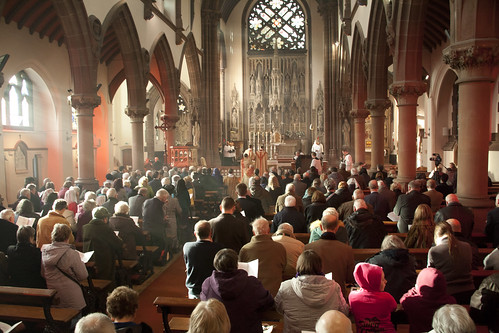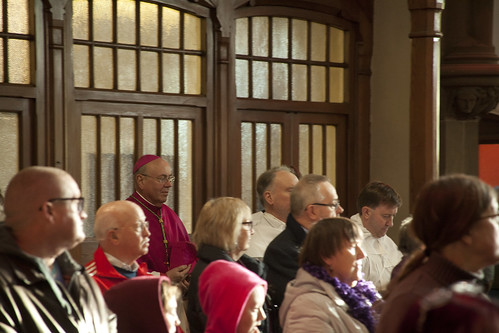 |
| St Mary's, Warrington: stuffed with regular parishioners experiencing the EF for the first time, thanks to the arrival of the Fraternity of St Peter. |
You report Mgr Charles Pope as warning that the popularity of the Traditional Mass may have 'reached its peak' (The best of the blogosphere, 15th Jan 2016).
Mgr Pope observes that in the early 1980s, Traditional Masses were often packed to the doors, but that things are different now. This is perfectly true, and is not due only to the fact that fewer Masses were on offer back then. In 1980, under the brief editorship of Christopher Monckton, the Universe conducted a survey of Catholics which showed that half would attend the Traditional Mass, were it available. Today, only a small minority would know what you were talking about.
Today, promoting the Traditional Mass is no longer a question of telling people that the form of the Mass they remember from a few years ago, and loved, is being said somewhere. It is, rather, a question of encouraging people to try out Mass in a form they did not know existed. This means that Masses at peculiar and irregular times, is rotating venues, and on weekdays, are not going to grow. What we have seen again and again is that where the Extraordinary Form is offered every week on a Sunday morning, even in places with no previous demonstrable demand for it, it quickly attracts a growing congregation of young people and families, and can play an important part in conversions and vocations to the priesthood.
Mgr Pope's diocese in the USA is, sadly, notoriously hostile to such celebrations. Nearly all the dioceses of England and Wales now have the Traditional Mass celebrated on Sunday mornings, and any readers who doubt the potential of the Extraordinary Form in the re-evangelising of England should visit one of these Masses and see for themselves.
Mgr Pope's diocese in the USA is, sadly, notoriously hostile to such celebrations. Nearly all the dioceses of England and Wales now have the Traditional Mass celebrated on Sunday mornings, and any readers who doubt the potential of the Extraordinary Form in the re-evangelising of England should visit one of these Masses and see for themselves.
Anyone who wants to see an example of people who'd no previous connection with the Traditional Mass being attracted by can see an example or two in every region of the country. The Institute of Christ the King in New Brighton are, of course, serving the long-term supporters of the Traditional Mass in their area, but the majority of the 80+ people who come to Mass at SS Peter & Paul and St Philomena didn't know about it till the Institute arrived. The same is true in Our Lady of Willesden in London, St Augustine's, Ramsgate, the chapel at the convent in Lanherne, Cornwall, and the Oxford and Birmingham Oratories. The London Oratory illustrates it too, having served a long-term traddy congregation in a chapel away from the main church, the Little Oratory, on a Sunday morning at 10am, they moved the EF to the main church at 9am and the numbers have rocketed, even though 9am is probably a less popular time than 10. Where did they come from? The general population.
I often hear complaints about how people 'won't make the effort' of going to peculiar and changing places at peculiar and irregular times in order to get to the EF. Such arrangements are appreciated by those already attached to the Traditional Mass, but you are that much less likely to discover it for the first time. People who've never heard of the Traditional Mass are obviously not going to be deeply committed to it. It doesn't reflect badly on them - that idea is absurd.
It is also worth considering that, while for some people it is love at first sight, and having seen it once they instantly become committed to seeking it out, most people need to experience the Traditional Mass a few times before they get into it. It takes a little getting used to. If they can pop into their usual parish at a regular time to see it every so often, perhaps when it happens to be the most convenient Mass time on a particular Sunday, they may learn to appreciate it. If they have to spend ages on the internet working out where it is, and then ages more getting there, they aren't going to expose themselves to its charms so readily.
 |
| Ordinary, local Catholics watching Archbishop McMahon enter their church, to install Fr Armand de Malleray FSSP as Rector of St Mary's Warrington. |
There is something rather disedifying, as well as irrational, about a priest lambasting a congregation for being insufficiently numerous. Let's stop blaming people for not knowing what has too often been deliberately hidden from them, and do our best to give them access to the liturgical riches which are every Catholic's birth-right.
Support the work of the LMS by becoming an 'Anniversary Supporter'.
Support the work of the LMS by becoming an 'Anniversary Supporter'.
I support the reintroduction of the TLM not for my benefit as a layman but for the sake of the clergy. What I find unacceptable is that the laity have become agents in the destruction of the sacred priesthood. It is the sacrality of the priesthood I wish, as a layman, to see restored. My own aesthetic preferences are an irrelevance in the affair. This is not about aesthetics or consumer choice. It is about the priesthood and the sacrifice of the Mass.
ReplyDeleteSo, I had too much time on my hands tonight during class, and counted up the number of Mass times in the Archdiocese of Washington. Turns out there's roughly 600. I also found only 3 EF Masses listed in his diocese, not the 5 Msgr. Pope mentioned. There were two additional Latin Novus Ordo Masses, so maybe he made a mistake.
ReplyDeleteI noticed Msgr. Pope derided Traditional Latin Mass attendance as 0.5% of the total number in his diocese while claiming that more TLM availability wouldn't make a difference. Would you like to guess how many Masses in the diocese are TLMs? Roughly 0.5%. Not as bad as he makes it out really.
Also, goes to show that maybe more availability could make a difference. Just a quick glance at Google Maps shows that there's parts of the diocese where you could easily drive past dozens of closer parishes to get to the TLM.
There are two more regular TLM's in Washington beyond the three listed, but neither is listed on their websites or the archdiocesan site, either (though they are advertised in other ways). But the unfriendly environment to the TLM in the archdiocese is certainly hard to dispute.
DeleteThe more pertinent point is that the TLM could be reintroduced tomorrow without warning in Washington and it would make no discernible difference to Mass attendance in the diocese.
ReplyDeleteMaybe not immediately. I expect some proportion of parishioners (10%) would probably quit in disgust if the change were not reversed the following week, following their loins straight into the Lutheran Church.
DeleteWe're living in a transitional time. Nowadays, it's only people in their 70s+ who remember the old Mass when it was the norm. My father is in his early 70s and only has the dimmest memories of it as a boy. However, 10, 15, 20 years ago, TL Masses were brimming with people who knew it when it was the norm. I remember back to those days feeling a bit 'special' or a bit of an oddity as a young person amongst mostly old-timers. Now it's all very different.
ReplyDeleteI am a lot younger than 70+ and remember it - beautiful - I even remember the first Sunday I arrived at Church and it had disappeared along with the Latin. It was the worse day of my life - even at that tender age - but I obviously didn't understand why at the time.
ReplyDelete